A huge part of implementing your marketing strategies will be determined by how you organize your contacts’ data within the platform. Custom fields give you the flexibility to create fields for information you need across all contacts. This guide has all you need to know about this powerful organization feature!
Introduction
Custom fields let you personalize your ActiveCampaign contacts on an individual level. If you need a piece of information that’s specific to each contact on your list, a custom field is the way to go.
Having your contacts and their information organized in the platform is an absolute key to implementing your marketing efforts correctly. And while tags work as subcategories for your lists, custom fields can help store information that is even more specific to each contact. Let’s use the below image of a contact record to explain.
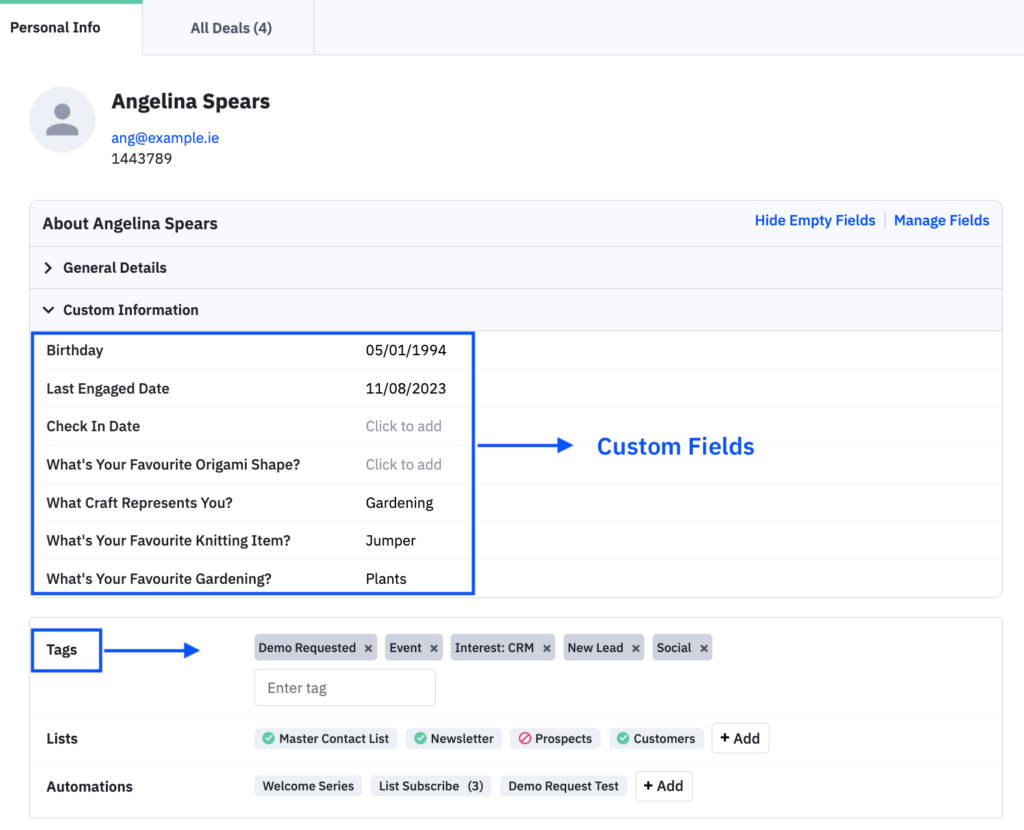
Custom fields give you the flexibility to create fields for information you need across all contacts. For instance, the ActiveCampaign user in the above example wanted to know the following:
- Birthday
- Last Engaged Date
- Check-in Date
- Favorite Origami Shape
- Type of Craft
- Favorite Knitting Item
- Favorite Gardening
The data collected via custom fields is diverse and personal. Of course, whenever contact data is in play, so is segmentation. In fact, custom fields are one of the main segmentation tools available to you in ActiveCampaign.
The rest of this guide further defines custom fields, and custom field types, and touches on how to create and use custom fields in ActiveCampaign.
Custom fields in ActiveCampaign
If you take away one thing from the below table — which compares lists, tags, and custom fields — let it be this: custom fields can do everything tags can do, and sometimes more.
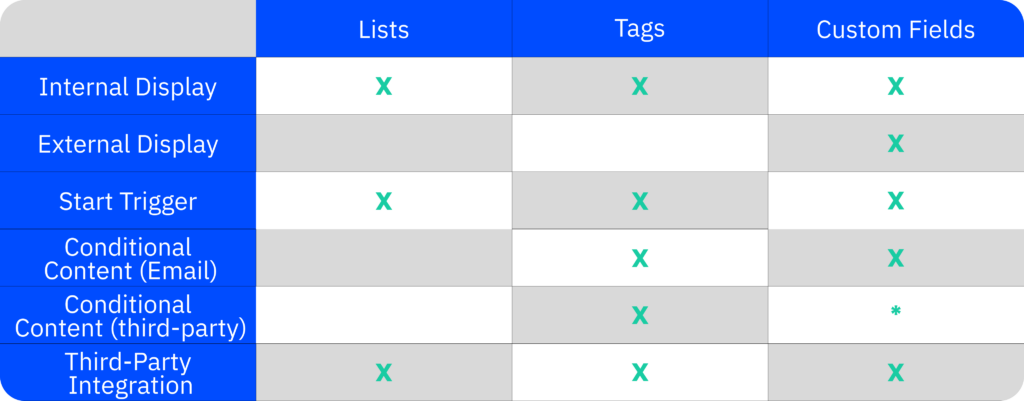
We point that out because users often overlook custom fields, unaware that custom fields are a powerful tool for segmentation.
Custom fields can be displayed internally to your business and externally to your contacts. That is, the data contacts submit by filling out forms is sorted into custom fields and can be displayed in your messages to them. Tags, on the other hand, are visible only to ActiveCampaign users.
Additionally, just like adding or removing tags, changes in custom field data can serve as start triggers for automations. As the above table shows, you can also use custom fields to configure conditional content blocks in emails.
To do so, you can follow the steps in this article or click the three white background dots that appear after hovering over a content block within the email editor, followed by clicking the Conditional Content icon.
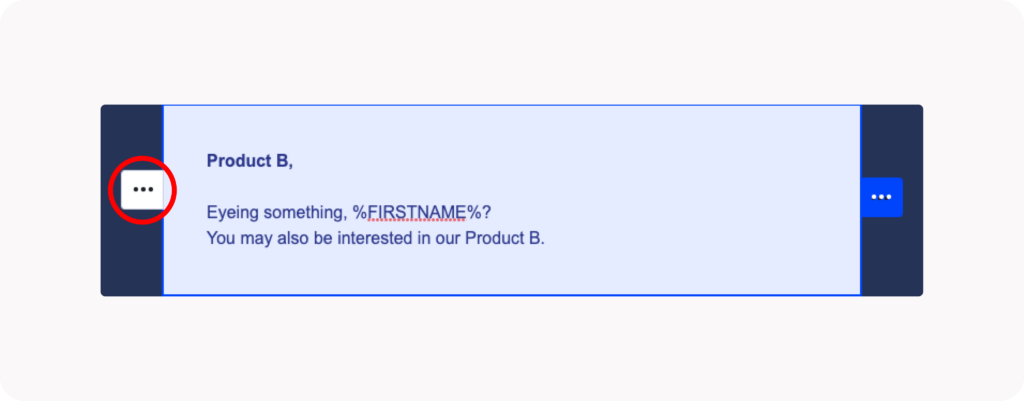
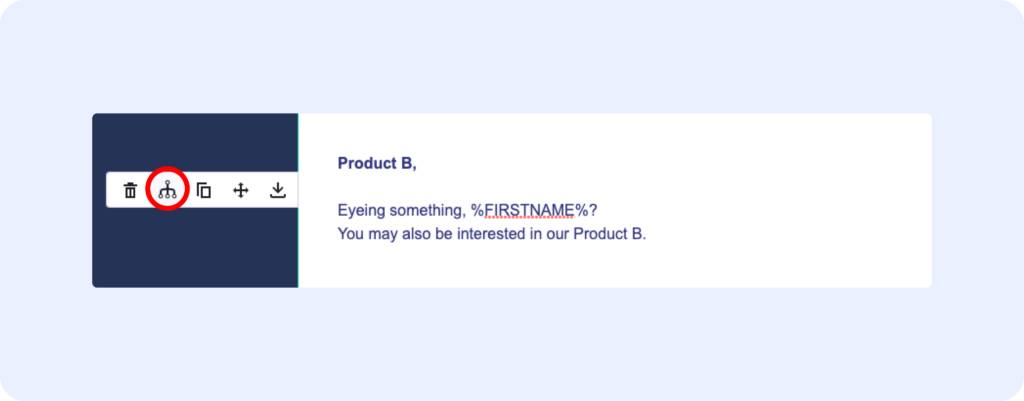
In the table, we placed an asterisk (*) in the custom fields cell that correlates to the “conditional content (third-party)” trait. That trait refers to the ability to hide and show content on your website via third-party integrations based on custom field data stored in ActiveCampaign. The problem is that most third-party tools do not integrate at a custom field level; most integrate only at a tag level.
So, the asterisk indicates that you can use custom field data to configure conditional content (another trait shared with tags) if the third-party tool can integrate and access the custom field data stored in ActiveCampaign. As technology advances, we expect that more third-party tools will integrate with custom fields.
Using Custom Fields For Personalization
Now, a key difference exists between making content conditional and personalizing content. To make content blocks conditional is to determine which contacts see the entire content block. To personalize content according to custom field data, autofill that data into a content block. So, any contacts who view such a content block will see something that is personal to them, such as their birthday, their first name, their favorite ice cream flavor, etc.
Perhaps you wonder how exactly you can leverage custom field data to personalize your engagements. Well, wonder no more! For each custom field you create, ActiveCampaign auto-generates a personalization tag (also known as a merge field). Click on the ‘Personalization Tags’ button and insert them into your messages, and voila! Your message will be personal to each recipient.
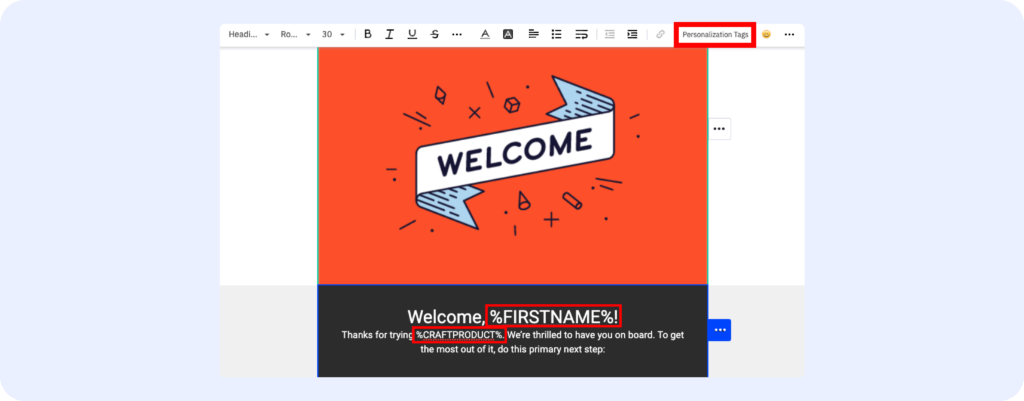
Types of Custom Fields
ActiveCampaign does not limit the number of custom fields you can create. Our platform does offer, however, a select amount of custom field types, which are shown below.
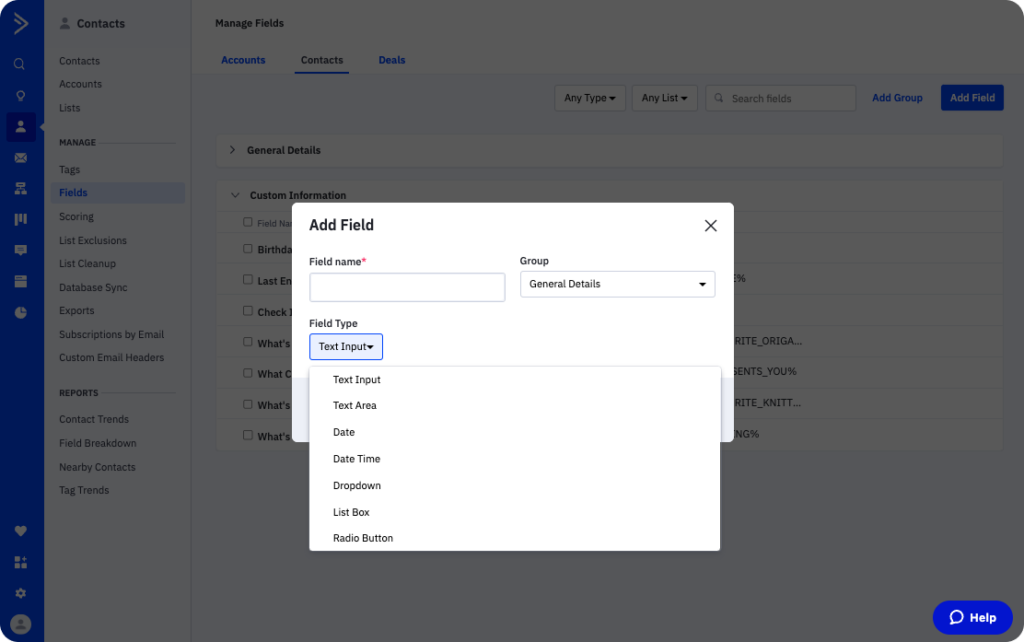
Let’s define them:
- Text Input: This is your traditional text input field. It is the primary means for storing data, which matches well with the fundamental purpose of custom fields.
- Text Area: The “Text Area” option simply allows for more text to be submitted than the “Text Input” option does.
- Date: This field allows you to capture a date (MM/DD/YYYY format). Additionally, the date field has a time stamping option. So, for example, you could record the exact date that contacts become customers.
- Date Time: This field is a date field but with time stamping option (MM/DD/YYYY HH:MM). So, for example, you could record the exact date that contacts become customers.
- Dropdown: This is your standard drop-down menu. As a rule of thumb, use the “Dropdown” field if you have ten or more options for contacts to choose from; if you present ten or fewer options, use the “Radio button” field (defined below). That advice is tied to visual representation. Scrolling through a drop-down menu is less overwhelming than looking at a screen of ten-plus radio buttons.
- List Box: This option looks similar to a drop-down menu and displays several options. However, contacts can shift-click to highlight more than one choice. This option mixes the visual appearance of drop-down menus with the function of the checkbox field type. Try not to include too many choices, as doing so creates a clunky, long form.
- Radio Button: This custom field type functions the same as the “Dropdown” type. Again, the difference between them is the visual representation. When presented with drop-down menus and radio buttons, users can select only one option (more on that in a moment).
- Checkbox: You can use this custom field type to tell you multiple things about a contact (compare that to a tag, which conveys only one detail). Contacts can check multiple boxes at once, which paints an accurate picture of their journeys. For example, maybe you want to know all the lead magnets that contacts downloaded. By presenting contacts with a checkbox field, they can tell you that exact information (I downloaded X and Y and Z).
- Hidden field: This custom field type is added to ActiveCampaign forms and will only be visible to you. Contacts submitting the form will not see this field. It is used to transmit specific information during a form submission such as UTM parameters or page information.
Note: In our “What Are Tags?” guide, we discuss status-related tags and how they require tag swapping to properly work. That is, contacts can logically have only one status-related tag assigned to them at a time; they can’t simultaneously be an active contact and unconfirmed. Thus, whenever you apply a new status-related tag, you must immediately follow up by removing the previous status-related tag. See the below automation:
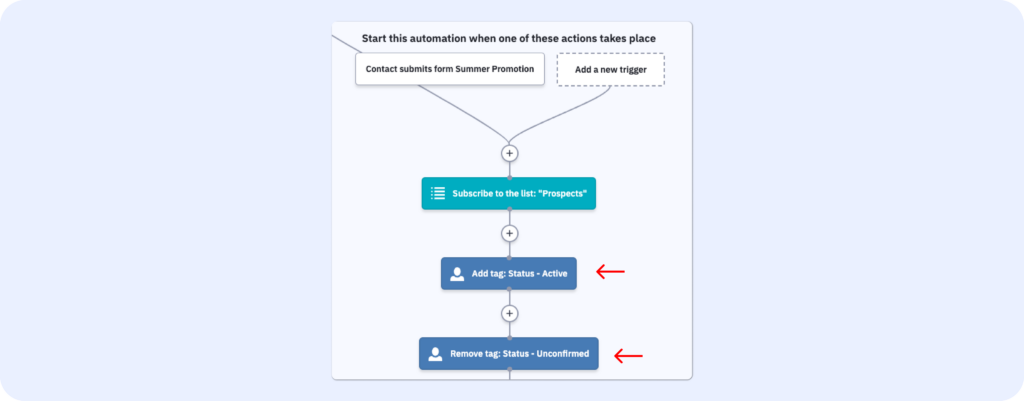
Now here is what’s interesting: drop-down menus and radio buttons can achieve the same effect of tag swapping, in one less step.
Remember, users can select only one option via drop-down menus and radio buttons. The difference between those custom field types and status-related tags is that you can update the data of a custom field, as opposed to removing and adding tags.
In the automation below, we simply add an action to update the “Contact Status” custom field. This action is the “Update a contact” action under the “Contacts” folder. By doing so, we can delete the tag actions as they are no longer necessary.
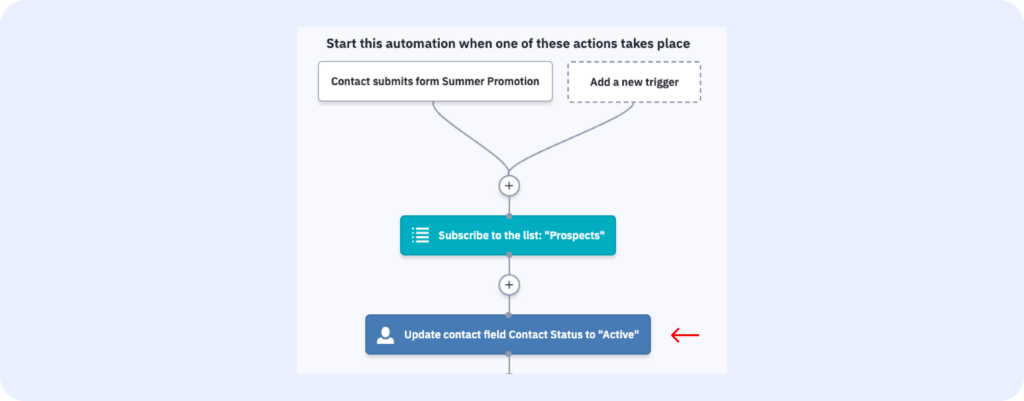
Such functionality makes your job easier and your marketing more powerful.
How to create new custom fields
Now that you have a good understanding of custom fields, here’s how you can create them:
- Click “Contacts” > “Fields”
- Make sure you’re in the “Contacts” tab if you wish to create a contact custom field.
- Click the blue “Add Field” button in the top right corner.
- Type the name of your custom field.
- Select the Group it will belong to (Groups are used to segment fields on contact records).
- Choose the Field Type.
- Click the “Add” button.
Note: As with many things in ActiveCampaign, you can access the different functionalities from several different places. Custom contact fields can also be created directly in the ActiveCampaign form editor, on contacts’ profile records, and via the Import contacts page. Please refer to this article for more information on these methods and the above.
Closing remarks
If used correctly, custom fields can help you target contacts to an unprecedented degree and ultimately fuel their progression through your business pipelines.
We suggest using custom fields to store data that tells the smaller yet crucial details of contacts’ stories. When viewed alongside lists and tags, custom fields paint a complete picture of each contact and empower you to automate hyper-personalized and relevant communication.
Do you have more questions about custom fields? Ask us in the comments section below!


